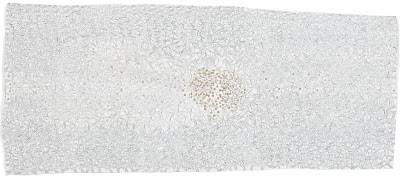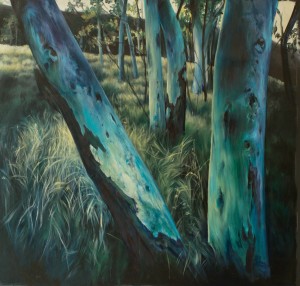The 29th Telstra National Aboriginal and Torres Strait Islander Art Awards (NATSIAA)
Tiwi artist Timothy Cook has won the 29th Telstra National Aboriginal and Torres Strait Islander Art Awards (NATSIAA) with a stunning painting in natural pigments depicting an important traditional Tiwi ceremony. Kulama, in Cook’s signature ochre yellow, red, black and white, was awarded the $40,000 prize on Friday night at the Museum and Art Gallery of the Northern Territory, Australia’s longest running Indigenous art award. Cook, a 53 year old, quiet man from Milikapiti, Melville Island, in the Tiwi Islands some 90 km north-west of Darwin, has been painting for some 13 years, and is the first Tiwi artist to win the award. At the announcement of his win on the Museum and Art Gallery of the Northern Territory lawns by the sea at sunset, he received enthusiastic applause from the audience, and was encouraged to perform his totemic Shark Dance with his fellow Tiwi friends and family, which he did, after much persuasion, with aplomb. It was a rare moment of pure joy in a oft-troubled industry that has suffered lately from much sorry business (the Aboriginal mourning following death), a damaged art market, low tourism, the social problems that plague Indigenous communities and the endless industry difficulties, from questionable dealers to the re-sale royalty (which is having the reverse intention of eliminating what was an important Aboriginalisation of the art industry, wherein artists successfully managed to be paid immediately for their works, rather than months later), and the Indigenous art-only code of conduct.
In an abrupt change from the awards of a few years ago, when there were many new media, photo media, photographic and conceptual installation works entered from Koori and Murri artists, and a highly-conceptual Murri artist (Danie Mellor) even won the award, this year there were few works in these mediums, and also few Koori entries in the final award exhibition (not one entry, for example, from Victoria or Tasmania). There was no New Media award given due to the lack of entries. Whilst the contemporary art world has embraced Indigenous artists from large towns and cities for their often cutting-edge art with its biting social commentary, their success in other areas and awards has led to less of these artists entering the NATSIAAs, feeling that it is no longer relevant to their careers.
Perhaps an emerging artist award could be a valid replacement, to new artists from all over Australia, with concerted effort to encourage artists from the south-eastern states to enter.
Cook’s work depicts the Kulama, an important increase ceremony, which is rarely held these days. It is an important work both artistically and culturally, due to the fading of cultural traditions plagueing Aboriginal society. When I visited Pirlangimpi (Garden Point), on Melville Island (Tiwi Islands) recently, the senior elder there Justin Puruntatameri (whose work, alongside his colleague’s Cornelia Tipuamantumeri was also included in this award) told me with great concern that the Kulama ceremony had not been held in his community for three years.
Cook’s work encompasses the Tiwi concept of Jilamara, which means ‘good design’: it is beautiful, strong, its composition well-balanced. I recently spoke with one of his long-time supporters, Gabriella Roy, of Aboriginal & Pacific Art, Sydney, who was exhibiting a work of his at the recent Melbourne Art Fair. She has been exhibiting Cook for some eleven years, and said that for many years, his work was difficult to sell. Tiwi art is much-admired by serious collectors, but its tribal rawness can be hard for the beginning eye to comprehend.
 |
| Raymond Zada, Racebook,
Giclée print on Hahnemuhle FineArt photo rag
|
The Work on Paper Award, Racebook, a digital print on paper, by emerging South Australian artist Raymond Zada, was the only conceptual winner. It received instant publicity from the media with its topical subject matter of racism on Facebook, with articles in The Age, The Financial Review, and The West Australian all leading with it and writing at length on it, rather than on the winner. The other winners, who are unquestionably more highly-skilled artists, were given far less immediate attention (articles that appeared later have however, written more broadly on the Award). While I commend Zada’s bold approach to confronting racism through art, his similarly important thoughtful reaction to contemporary issues which are played out through social media, the derivativeness of the work does give some cause for concern. The work’s design, consisting of large letters filled with small quotes of racist remarks, is perhaps too evocative of the Austracism series of works by Queensland artist Vernon Ah Kee.
 |
| Barbara Moore, Untitled, Synthetic polymer paint on linen 197 x 200 cm. |
The General Painting Award was given to Barbara Moore, an Anmatyerre woman from Ti Tree in the Northern Territory who is based at Amata, South Australia, working through Tjala Arts. Her vibrant, expressionistic, painterly depiction of her country, described as ‘hyper-energetic’ by the judges (artist Bindi Cole, curator Glenn Iseger-Pilkington and academic Roger Benjamin), was powerful with its palette of rich yellows, reds, purples, pinks and oranges, subtle use of black and white, its broad sweeping brushstrokes depicting circular rockholes and important sites. While superficially abstract, her work is in fact deeply representative of the rockhole and soakage site she is depicting. The vast distances of country whose designs she has inherited ownership of recall that other great Anmatyerre painter, Clifford Possum Tjapaltjarri. While language groups are distinct and land ownership is sacrosanct in Indigenous culture, there are often overlapping areas and people may belong to several language groups through their ancestry. As an Anmatyerre woman with connections to the vast area north and west of Alice Springs, now living in the Pitjantjatjara lands to the south, Moore’s paintings encompass several schools of Indigenous ‘desert’ art. The influence of her Pitjantjatjara colleagues’ extraordinary colourist and sophisticated landscape paintings, one of the most significant of all Australian landscape painting schools, has given her work a fresh, energetic vibrancy.
 |
| Djirrirra Wunungmurra, Yukuwa, Natural pigments on bark 236 x 100 cm. |
The Buku-Larrnggay Mulka art centre in Yirrkala, east Arnhem Land, has been a consistent award winner at the NATSIAA, and this year was no different, with a stunning, elegant large bark, entitled Yukuwa, by Djirrirra Wunungmurra winning The Telstra Bark Painting Award. Yukuwai, a yam whose annual reappearance serves as a metaphor for the increase and renewal of people of their land, is depicted in delicate, intricate leaves and small flowers in a white ochre palette, with occasional use of a deep yellow ochre, on a flattened piece of Eucalyptus bark well over two metres tall. One would never guess that this beautifully calm work is in fact partly the result of an argument, when a family member challenged Wunungmurra’s right to paint bukyu, the fishtrap imagery of her clan and homeland. ‘Rather than argue’, her art centre explains, ‘she retorted by painting imagery that is in one sense her own personal identity’. Its intention as an ‘almost self-portrait’ is also indicative of the wonderful complexity of Indigenous art, and its often secretive, mysterious constructions: for Yukuwa is one of the personal names of the artist. In Yolgnu society, one receives an invitation, in the form of an object representing a yam with strings emanating from it, with feather flowers at the end, to the ceremony held to strengthen relationships between clans belonging to the Yirritja moiety. The strings represent the kinship groups that are tied together.
Such an object is evocative of the winner of the Wandjuk Marika Memorial 3D Award (sponsored by Telstra), an almost abstracted sculptural depiction of Namorroddo, a malevolent being from the creation period (view video here). Comprised of paperbark, bush string, natural pigments, beeswax and feathers, the inky blackness of the ochre paint is in fact upon closer inspection a captivating deep indigo violet, highlighted with seven large white ochre shapes in a line around each side of the slim, tall spherical object, with delicate bush string emerging from either side, each finished with a small bunch of feather flowers. The artist, Jack Nawilil, is of the Rembarrnga language group, and lives in the central Arnhem Land community of Maningrida, a significant Arnhem land community renowned for its fibre work. Namorroddo, he says, flew through the air over great distances, like a ‘shooting star’, from Gapuwiyak in the east, westwards to Ramingining, descending on places to look for honey, to murder men and then alight again. He represents the Lightning Spirit in traditional Rembarrnga mythology, and the dangers of the night, the time when he travels. Nawilil’s work is both traditional and labour intensive, roots for dyes and bark must be gathered, soaked (the paperbark is soaked on the beach in saltwater), the string is made by vigorous, continuous rubbing on the thighs, the object itself constructed from extensive wrapping of the paperbark.
This years selection was the smallest in the history of the award, with only 63 works, from only 300 entries. And yet there were many beautiful works, although they may be becoming overly familiar to the indigenous art enthusiasts. Overall, the winners represented an important overview of contemporary Indigenous Australian art and some very fine and significant Australian artists.


Recent Comments